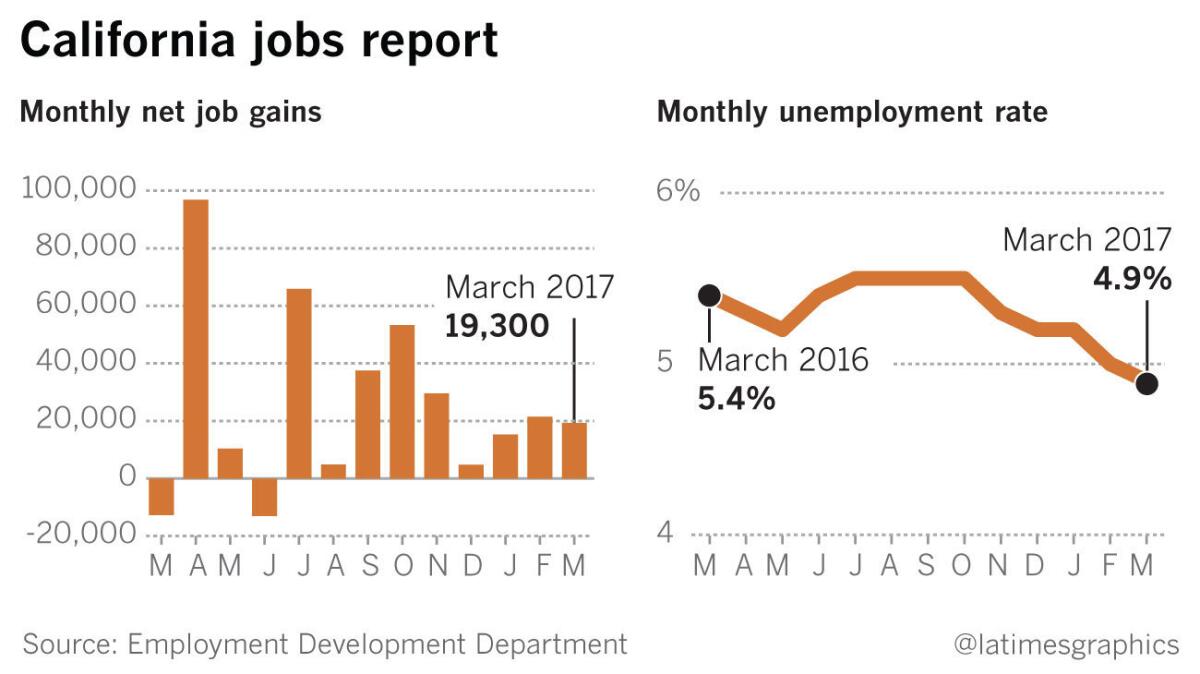Unemployment in California falls to 4.9%, lowest since 2006

- Share via
California piled on 19,300 jobs in March and its unemployment rate dropped to 4.9%, according to figures released Friday by the state’s Employment Development Department. That’s the first time since December 2006 that the jobless rate has fallen below 5%.
It was another month of solid but not breathtaking job gains in a state that has slowed a bit after years of unbridled growth.
Still, California grew faster than the rest of the country in March, expanding at a rate of 2.1% year over year, compared with 1.5% nationwide. Californians were still slightly more likely to be unemployed; the U.S. jobless rate hit 4.5% in March.
The standout sector in March was construction, which increased payrolls by 18,900. The information sector — which includes tech businesses in Silicon Valley and moviemakers in Hollywood — faltered last month, cutting head count by 9,400.
Los Angeles County gained a net 16,000 jobs in March. The county's unemployment rate fell to 4.6%, down from a revised 4.8% in February.
Here are some key insights into the latest labor-market report from the world’s sixth-largest economy.
» Inland Empire had some of the biggest job gains in the U.S. recently

California powered the nation
In March, California produced about 20% of the job growth in the entire country, which added 98,000 jobs last month. The state is huge, but it only accounts for about 11.5% of the country’s employees, which means that it is punching above its weight.
“We get beaten up for being a high-cost and high-tax state … but we have been outperforming many states,” said Robert Kleinhenz, an economist at Beacon Economics, a Los Angeles consulting firm.
California alone was responsible for 16% of the country’s growth from 2014 to 2016, according to Kleinhenz’s analysis.

Blame Hollywood, not Silicon Valley
The information sector can be hard to analyze, because the state defines it as a mash-up of businesses involved in entertainment, news, data and software. The seasonally adjusted figures show the industry lost jobs last month, but has performed well in general over the last 12 months, adding 8,700 jobs since last March.
But that good news is mostly a function of an unstoppable tech industry. Software publishers, data processing companies and other information service providers added a combined 16,100 jobs year over year.
The movie business hasn't been as good to job seekers; motion picture and sound recording industries have cut payrolls by 6,000 people since last March. (Those figures are not adjusted for seasonality.)

Farmers are caught in a labor shortage
California usually has a higher share of people unemployed than the rest of the country.
Now the state’s jobless rate is just four-tenths of a percentage point higher than the nation's, and Los Angeles is only one-tenth of a percentage point above.
What gives? Chalk it up to strapped farmers.
In California’s large, seasonal agriculture economy, farmworkers may be left without work at various points throughout the year.
But the farm-labor market in California has been tightening, as fewer and fewer people cross the southern border, thanks to Obama’s strict border enforcement and Trump’s promise to ratchet it up even more.
Growers are giving their laborers huge raises, and their farmworkers are finding it easier to stay employed throughout the year. In 2014, people who cultivate crops worked 205 days in the year, up from 178 days in 1990.

Get ready for more tepid growth
California and the rest of the country have reached the point where it isn’t possible to heap on tons of new jobs because there aren’t tons of people left who want to be hired.
The labor force — meaning everyone who has a job or is looking for one — is growing more slowly than it has in recent years. Joblessness is near historic lows.
The only way to continue to grow, assuming demand for workers stays high, is to widen the pool of people who can work. Trump’s promise to kick out everyone living here illegally and seal the border will do the opposite, experts say.
“Here in California people aren’t coming over the border, and that’s the Trump effect; the rhetoric has caused people to shy away from making that dangerous trek,” said Chris Thornberg, the founding partner of consulting firm Beacon Economics. “Our ability to grow faster than the nation is going to depend on our ability to attract people to move here.”
But California can’t get people to cross state lines. Housing is too scarce and expensive to get Arizonans or Texans to relocate, Thornberg said.
The upshot is that workers become more valuable and should be able to command higher wages.
Pay has been rising more quickly across the state. Over the last 12 months, hourly pay went up by $1 in California, about 4%, according to federal data. Over the previous 12-month period, it only rose by 45 cents, or nearly 2%.
Follow me @NatalieKitro on Twitter
ALSO
Wages rise on California farms. Americans still don’t want the job
Immigrants flooded California construction. Worker pay sank. Here’s why
Inland Empire had some of the biggest job gains in the U.S. recently
UPDATES:
4:30 p.m. This article was updated with additional analysis and details on industry sectors.
9:25 a.m.: This article was updated with figures for Los Angeles County.
This article was originally published at 9:10 a.m.
Inside the business of entertainment
The Wide Shot brings you news, analysis and insights on everything from streaming wars to production — and what it all means for the future.
You may occasionally receive promotional content from the Los Angeles Times.








